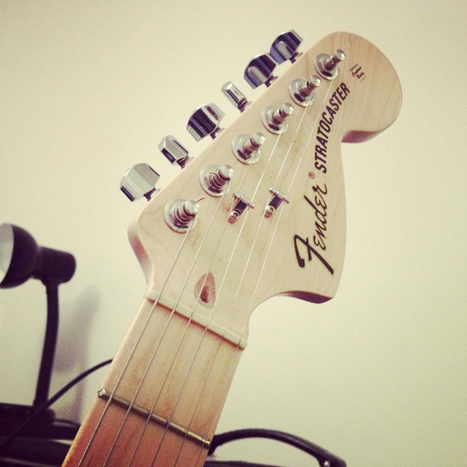

It is pretty much an unavoidable thing that happens in every guitarist’s lifetime. We get in ruts. The difference between great players, and players that tell you that they have pretty much given up, is that great players’ know how to steer out of the ruts.
I want to share with you, my 7 top tips on getting your guitar playing out of the ruts and back on the highway of rock ‘n’ roll! What’s best about learning how to get out of a rut, is that you learn the techniques once and become aware of when you might be in a rut, and avoid it at all costs from that day onwards.
So, here we go, lets get stuck into the guitar and have some fun starting from today! Try a technique at a time over the next week and I promise you will want to share these tips with everyone.
1. Listen to a different style of music
Head straight to Spotify or where ever you like to get your music from, and start listening to some music you have never heard before. Honestly, you will be surprised how much your listening affects your playing. If you are an acoustic-pop guitarist, try listening to some hip-hop and hear what the guitar is doing. If there is no guitar part, could you make a part to compliment the track? Perhaps you are a shred guitarist and have become slightly lost in a sea of notes? Try listening to some simplistic music, the type of music often found in film and performed on the piano. Appreciate the note choice and try your hand at working out the note use over the chosen chord.
This is my top tip because it has helped me become a diverse guitarist and it develops your ear.
2. Take a guitar lesson
Ok, I know I am a guitar tutor in Brighton, but I honestly do believe in the value that taking guitar lessons holds. If you explain your current level, tastes and where you want to take your playing, any good guitar tutor should inspire, and put you into action. Quite often, just seeing a good guitarist up close and explaining what he is doing, will be enough to clear your guitar-haze. Give your guitar teacher pieces of music you want to aim towards, and ask about realistic time frames for how long it will take for you to be able play the song.
3. Jam with someone
If you have any time to spare at all, then please find a local musician to jam with you, even just one night a week. Sharing musical ideas and writing parts to compliment each other’s lines will improve your musicality, and give you an idea of how flexible you are. You will also get a good look at how even your rhythm and lead skills are, as you trade off accompaniment.
4. Record yourself
Now, I know this is not quite as easy to do as some of my other tips, but if you have access to recording yourself, then go for it. It is scary at first hearing yourself, but you will get used to it and learn how be critical about your playing, in order to produce a recording you can’t wait to share. You learn how to interweave guitar parts, making use of a variety of tones to create the ambience you are looking for.
5. Experiment with an alternative tuning
This is a really fun way to get out of a rut and an excellent way to make some beautiful sounds you never knew you could make. Investigate into open G and open D tuning for starters, and learn what notes to tune the strings to. What is amazing about this technique is that you can’t rely on your trick book anymore, and unless you learn someone else’s music in this tuning, you rely fully on your musical creativity rather than shape and memorized patterns. Some players get so engrossed in alternative tunings that they never turn back and become completely shaped by the tuning.
6. Attempt to play music performed on another instrument
As guitarists, we quite often have an array of tricks and approaches that we pull out at any time, often slightly adapting them to fit the musical situation at the time. If you consider that the notes we play are largely in part due to the shapes we were told to learn, then you start to realise why many guitarists sound the same. A lot of great guitarists I have met over the years have had this one attribute in common; they all listen to music from piano, saxophone, violin and trumpet, and pretty much any melodic instrument as well as rhythmic instruments to build a great rhythmic command. Being able to take music from another instrument and perform it on guitar may be my number 6 top tip, but it is an art well worth mastering.
7. Immerse yourself in music
Picture music as your fuel. You need fuel to run, and when music equals creativity, then why not immerse yourself in a sea of songs? Find the time to listen to music, both consciously and sub consciously. By that, I mean sometimes have the music as a background sound and then at other times listen to the music and imagine how to play the parts. Pay attention to the tone, dynamics, note choice, space and development of a part throughout the song.
So, that was my 7 top tips that will hopefully guide you out of the woods and onto the road next time you are lost, whilst on your pursuit of guitar mastery.
Tom Clark is the founder of Your Guitar Tutor, and is a guitarist who is passionate about sharing expert advice on anything guitar.

THANK YOU MUCH!, WILL SHARE THIS VALUEABLE INFORMATION! YAH BLESS YOU and YOURS!!! Cheerful Art (ETURTLE) E.T. SOUNDS and LIGHTS
When I get in a writing rut, I like to take a break from the guitar. For example, instead of playing every day, I will take two days off. It is amazing how two days of not playing will open up some new directions when you play again.
I second learning a new technique as well. Maybe sweep picking or arpeggios, triad runs, diads, etc. are not something you have developed. It seems to me that even after many years of playing, there is always a new technique I have not mastered or don;t use much in my playing.
Thanks for the tips!
Practice! i am a fiend when it comes to practice (4 to 6 hrs a day). Ruts come from not having anything new to say with your axe. Repetition, improv, Sound settings, and hard work will keep you out of ruts. i haven’t been in one for 35 years. If you just do your gigs and practice very little, expect them constantly.
Glad you guys like my post! I am always trying to inspire players around the world to just pick up the guitar, and remember how much you loved it at a time in your life.
Another point to add to this list would be to watch films that move you. Stimulating your mind with a different medium is great from time to time. Any questions please email me and I would love to help 🙂
Thanks,
Tom
Absolutely spot on thanks
I am one that did get in serious rut and stopped playing for almost 10 years. I was in-between bands and just wasn’t enjoying it. For me it became just like any job and since it wasn’t paying the bills it was hard to stay focused. I regret greatly not powering through it. These tips would have been invaluable back then. I have since returned to playing although my chops are no longer what they used to be. That being said I now play for the shear pleasure of playing. I think that is a big factor in getting into ruts. People forget that its supposed to be enjoyable. It becomes a chore. Don’t let it become tedious. Silly as it sounds I rediscovered my love of playing by playing children’s songs my kids liked. I found myself tweeking and transposing them and just having a great time.thanks for posting this a lot of players should take your advise.
I either buy or build a new guitar. That get’s me excited about playing again.
Almost 30 yrs of playing here. I have been through these ruts and used the very same techniques you suggest – particularly listening to all different kinds of music.
Sometimes, I need to put the guitar down for a couple of days – let my “well of creativity” fill up again – allow myself to get re-inspired and to do so, listening to something completely out of my comfort zone or something I haven’t heard in ages really works well.
Keep jamming!
I find that simply playing songs, instead of going through the daily ritual of technical exercises, helps me get out of a rut. There are so many guitar lessons on YouTube or apps like Tab Pro that practically every song you’ve ever listened to on the radio is out there. If I already know a song, I just play along. If I don’t know the song, I learn it. I may not be “progressing” in a technical sense, but I am having fun playing and learning music.